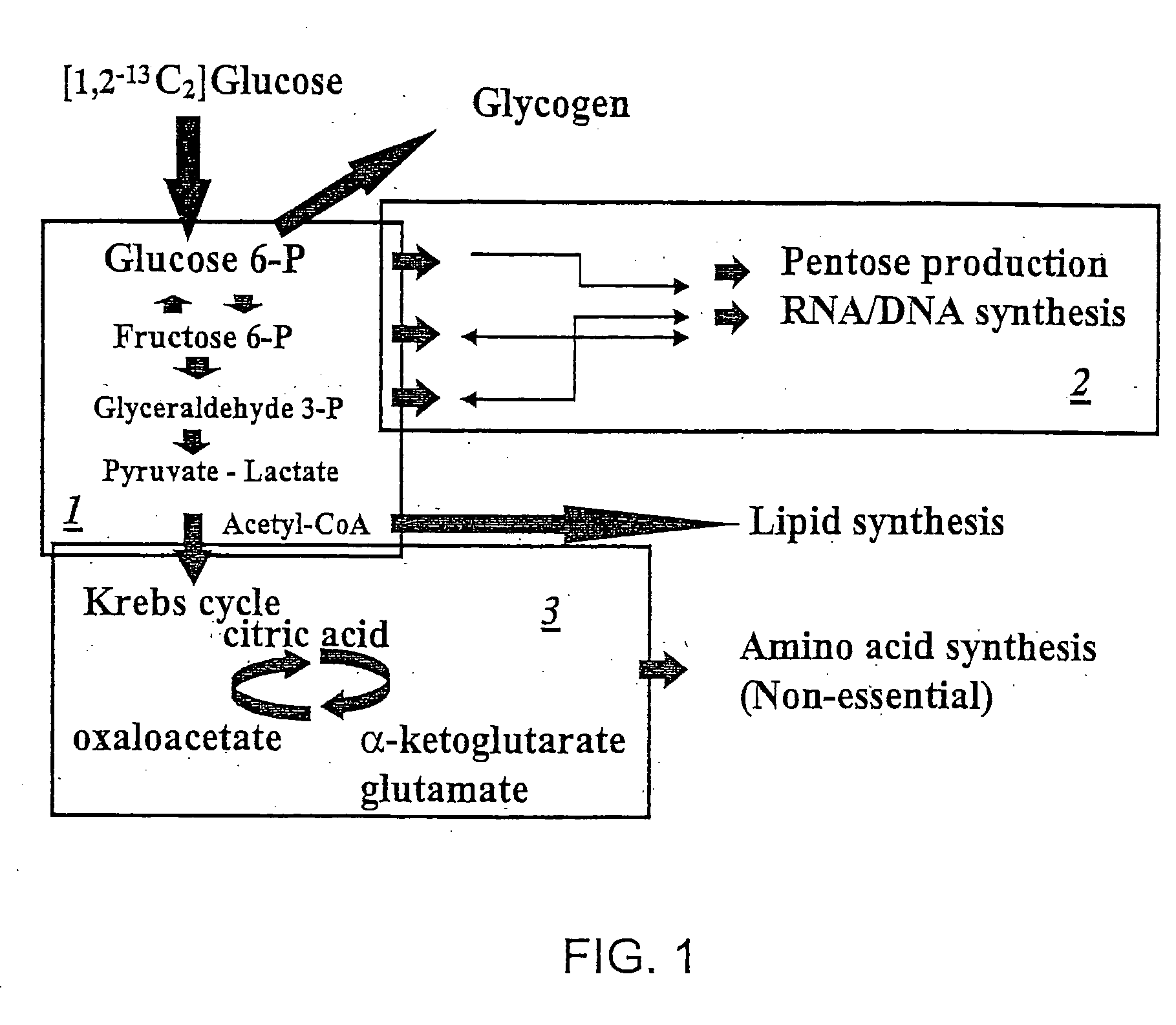Stable isotope based dynamic metabolic profiling of living organisms for characterization of metabolic diseases, drug testing and drug development
- Summary
- Abstract
- Description
- Claims
- Application Information
AI Technical Summary
Benefits of technology
Problems solved by technology
Method used
Image
Examples
example 1
13C Labeled Glucose—Control / Test System
[0116] The details of how the invention can be carried out can be better understood by reference to the figures. For example, FIG. 3 shows the structure of a preferred embodiment of a labeled glucose molecule along with possible rearrangements of 13C in various metabolites of glycolysis using [1,2-13C2]glucose as the single tracer. Glucose activation via hexokinase / glucokinase and the formation of fructose-1,6-bis phosphate maintain the 13C labeled carbons in the 1st and 2nd positions. 13C-labeled carbon positions derived from [1,2-13C2]glucose are shown by the “13” superscript, while 12C native-labeled carbon positions are shown by the “12” superscript. Participating enzymes are italicized in all of the figures. Thus, a single version of the invention can be carried out by creating two separate cell culture systems. The first system is a control system which includes the 13C labeled glucose which may be [1,2-13C2] glucose. The control system ...
example 2
13C Label at Many Positions—Standard / Test Systems
[0117] In addition to labeling glucose as shown in FIG. 3, it is possible to label glucose at other positions and / or to label other molecules such as [2,3-13C2] dihydroxy acetone-P or to continue to track the molecule of [2,3-13C2]dihydroxy acetone-P created in the reaction shown in FIG. 3. FIG. 4 shows the structure of the labeled compounds involved in the formation of [2,3-13C2]lactate through the Embden-Meyerhoff-Parnas pathway. The production of three-carbon metabolites by aldolase (as shown in FIG. 3), glyceraldehyde and dihdroxy acetone phosphates transfers the labeled carbons into the 2nd and 3rd positions of glyceraldehyde. There are no subsequent positional changes in terms of 13C labeling by triose phosphate isomerase in the three-carbon metabolite pool that undergoes glycolysis, resulting in the release of lactate. Thus, the method of the invention can be carried out as described above in Example 1.
[0118] Those skilled in...
example 3
Pentose Cycle Metabolites
[0119] The labeled glucose as shown in FIG. 3 can be acted on differently as the reactions of FIG. 5 show. FIG. 5 shows the structure of compounds involved in the rearrangement of 13C in pentose cycle metabolites due to direct glucose oxidation. The loss of the first labeled carbon of glucose due to direct oxidation produces ribose molecules that are labeled only on the first position with 13C. During the oxidation of glucose 13CO2 is released, which can easily be detected using isotope ratio mass spectrometry (IRMS). Reducing equivalent NADP+ is also produced that can be used in lipid synthesis, DNA nucleotide production or to maintain reductive / oxidative reactions throughout metabolism. The invention is particularly useful in monitoring the effects of drugs on these biochemical processes—using methods a described in Examples 1 and 2 above.
PUM
| Property | Measurement | Unit |
|---|---|---|
| Electric charge | aaaaa | aaaaa |
| Time | aaaaa | aaaaa |
| Molecular weight | aaaaa | aaaaa |
Abstract
Description
Claims
Application Information
 Login to View More
Login to View More - R&D
- Intellectual Property
- Life Sciences
- Materials
- Tech Scout
- Unparalleled Data Quality
- Higher Quality Content
- 60% Fewer Hallucinations
Browse by: Latest US Patents, China's latest patents, Technical Efficacy Thesaurus, Application Domain, Technology Topic, Popular Technical Reports.
© 2025 PatSnap. All rights reserved.Legal|Privacy policy|Modern Slavery Act Transparency Statement|Sitemap|About US| Contact US: help@patsnap.com



